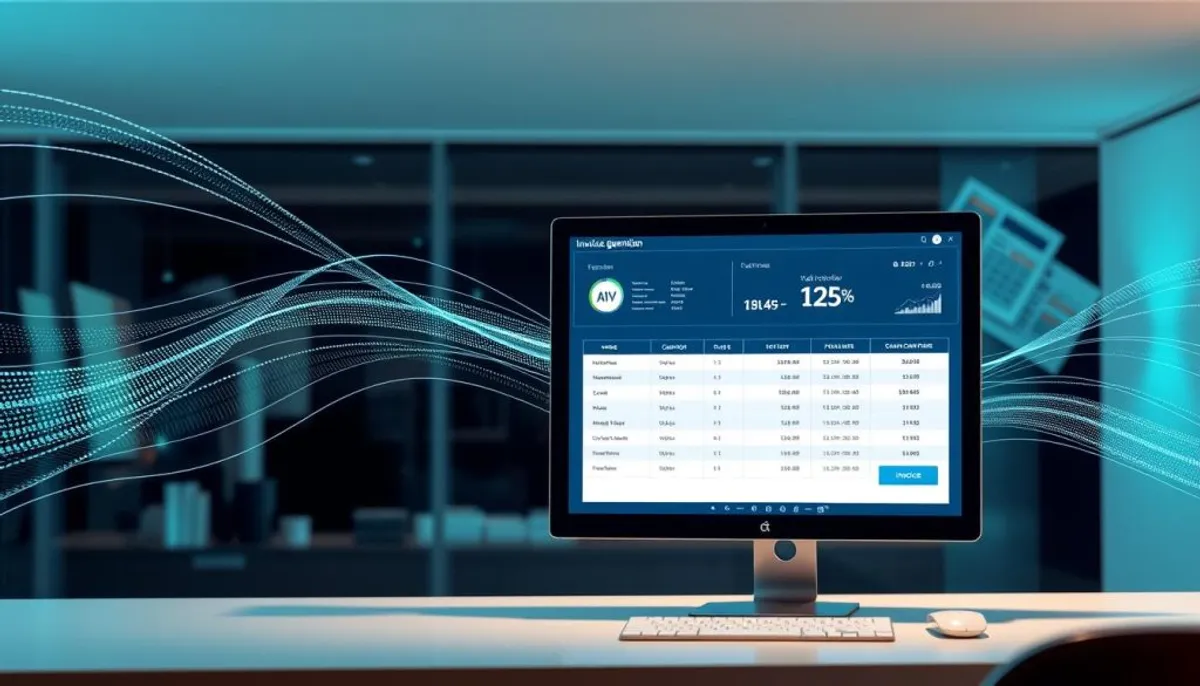In today’s fast-paced business world, accounts receivable automation is revolutionizing financial operations. This innovative technology streamlines invoicing processes and significantly improves cash flow. By implementing AR automation, companies can tackle common challenges and unlock a wealth of benefits.

Recent studies highlight the growing importance of AR automation. A Wakefield-Versapay report found that 77% of AR teams face invoice processing delays. Yet, businesses leveraging automated AR software can save up to $4.9 million annually in consumer bad debt. These statistics underscore the potential for substantial improvements in efficiency and financial stability.
Accounts receivable automation benefits extend beyond cost savings. It enhances customer experiences, with 97% of C-level executives recognizing its critical role in AR processes. By offering convenient payment methods and streamlined communications, businesses can foster stronger client relationships while accelerating cash flow.
Key Takeaways
- AR automation can save 35,000 administrative hours annually
- Streamlined invoicing reduces Days Sales Outstanding (DSO)
- Improved cash flow forecasting through real-time data access
- Cost savings exceeding 70% in invoicing expenses
- Enhanced customer experience with self-service portals and multiple payment options
- 87% of businesses report improved process speed with AR automation
Understanding Accounts Receivable Automation
Accounts receivable automation revolutionizes financial management for businesses. It streamlines invoice processing, payment tracking, and cash flow management. This results in enhanced efficiency and precision.
Definition and Core Functions
AR automation employs software to manage accounts receivable tasks. It encompasses invoice creation, payment processing, and collections management. This technology minimizes manual effort and accelerates the receivables cycle.
Evolution from Manual to Automated Systems
The transition from manual to automated AR systems has been groundbreaking. A survey of 1,000 C-level executives revealed 96% acknowledged the necessity of digitizing AR processes. This shift tackles major hurdles like time-consuming data entry and error-prone procedures.
Key Components of AR Automation
AR automation systems comprise essential components:
- Automated invoice generation and delivery
- Payment processing and tracking
- Collections management
- Reporting and analytics capabilities
| Benefit | Impact |
|---|---|
| Reduced payment delays | 32% decrease in days sales outstanding |
| Increased productivity | 77% of collections teams updated in real-time |
| Error reduction | 63% drop in billing mistakes |
By adopting accounts receivable automation, companies can notably enhance their financial operations. This leads to superior cash flow management and increased overall efficiency.
The Current State of AR Management Challenges
Businesses encounter substantial obstacles in managing accounts receivable. The reliance on manual AR processes introduces a cascade of inefficiencies, jeopardizing financial health. Invoice processing delays are a major concern, with 77% of AR teams experiencing such issues.
These delays are often caused by outdated invoicing methods, operational errors, and insufficient technology. The consequences are far-reaching, affecting cash flow management directly. Delayed invoices result in delayed payments, destabilizing a company’s financial standing.
Manual AR processes also suffer from error-prone data entry. Incorrect invoices lead to customer disputes, further prolonging payment delays. Misapplication of payments to incorrect invoices exacerbates the issue, creating a complex financial discrepancy.
| Challenge | Impact | Solution |
|---|---|---|
| Invoice processing delays | Extended payment cycles | Automated invoice generation |
| Error-prone data entry | Customer disputes | Digital data capture |
| Poor cash flow management | Financial instability | Real-time financial insights |
Inefficient cash flow management poses a significant challenge. Without real-time visibility into receivables, businesses face difficulties in making informed financial decisions. This lack of clarity can result in missed growth opportunities and potential cash shortages.
Accounts Receivable Automation Benefits
Accounts receivable automation offers numerous advantages to businesses. It streamlines processes, enhancing financial operations and customer relationships significantly.
Reduced Manual Labor Requirements
AR automation dramatically reduces the time and effort required for accounts receivable tasks. It eliminates the need for manual data entry, allowing staff to concentrate on strategic activities. This not only increases productivity but also reduces operational costs.
Enhanced Cash Flow Management
Automated systems expedite payment processing, improving cash flow forecasting. This contributes to a healthier financial state, supporting ongoing business objectives. Automation also lowers Days Sales Outstanding, indicating quicker payment collections.
Improved Accuracy and Error Reduction
AR automation minimizes errors by reducing manual touchpoints. Technologies like AI and machine learning continuously refine processes, enhancing accuracy over time. This leads to fewer discrepancies and smoother financial operations.
Real-time Data Access and Reporting
One of the key benefits of AR automation is real-time data access. It provides instant visibility into invoicing and payment statuses, facilitating better decision-making. Automated reporting tools offer valuable insights, enhancing overall financial management.
By leveraging these benefits, businesses can enhance customer experience through faster, more accurate billing processes. The combination of minimized errors, real-time data access, and streamlined operations contributes to improved efficiency and customer satisfaction.
Streamlining Invoice Processing with ti3
The ti3 service transforms accounts receivable management with its advanced invoicing and automated reminders. It addresses common issues businesses face, notably in invoice processing and payment collection.
Automated Invoice Generation
Manual invoice creation is a thing of the past with ti3. The system automatically generates invoices, reducing errors by up to 66%. This automation slashes processing time by 80%, freeing up businesses to concentrate on their core activities rather than administrative tasks.

Digital Delivery Systems
Ti3’s digital delivery system redefines how invoices are sent to clients. Electronic invoicing results in cost savings of 60-80% compared to traditional methods. This method not only reduces expenses but also accelerates payment processing, cutting times in half compared to paper-based systems.
Payment Tracking Features
Ti3 excels in tracking payments. Its automated reminders significantly boost the chance of timely payments by 8 times when due dates are clearly communicated. This feature is essential, as 33% of SMEs face over two months of waiting for overdue invoices, severely affecting their cash flow.
By adopting ti3’s streamlined invoicing process, businesses can minimize late payments, enhance cash flow, and concentrate on expansion rather than pursuing overdue accounts. The platform’s all-encompassing approach to invoice management positions it as a critical asset for contemporary enterprises aiming for efficiency and financial solidity.
Accelerating Payment Collections
Accounts receivable automation transforms payment collections, tackling major hurdles for businesses. Automated systems lead to fewer payment delays and better cash flow. This shift from manual to automated processes eases stress for remote teams, essential in today’s interconnected business world.
Automated payment reminders are crucial for boosting operational efficiency. They ensure customers are timely notified, prompting them to pay invoices without delay. This approach cuts down manual follow-up time and minimizes the chance of missed payments.
Real-time payment tracking is a transformative feature of AR automation. It removes the delay in data updates, allowing collection managers to work with the latest information. This real-time insight enables swift decision-making and targeted follow-ups, speeding up the payment collection process.
| Manual Process | Automated Process | Benefits |
|---|---|---|
| Time-consuming data entry | Automated data capture | Reduced errors, time savings |
| Delayed payment updates | Real-time tracking | Improved cash flow management |
| Manual reminders | Automated payment reminders | Reduced payment delays |
AR automation streamlines these processes, enhancing collections, cash flow, and overall efficiency. This leads to a more agile, responsive, and financially robust business operation.
Enhanced Customer Experience Through Automation
Automation in Accounts Receivable (AR) transforms customer interactions. Self-service portals empower clients, allowing them to manage their invoices independently. This empowerment not only benefits customers but also streamlines business operations.
Self-service Portal Benefits
Self-service portals grant 24/7 access to account details. Customers can review invoices, make payments, and monitor transactions at their convenience. This convenience significantly reduces the need for customer support, enhancing overall satisfaction.
Multiple Payment Options
Automation introduces a variety of payment options. Customers can select from ACH, credit cards, or third-party AP portals. This flexibility meets diverse customer needs, accelerating payment processing.
| Payment Method | Benefits |
|---|---|
| ACH | Fast, secure, low-cost |
| Credit Card | Instant, rewards points |
| AP Portal | Integration, efficiency |
Improved Communication Channels
AR automation enhances communication channels. It ensures immediate access to invoice documents and account information. This transparency accelerates dispute resolution and fosters trust. A study indicates that 95% of executives believe collaboration reduces invoice disputes.
Businesses acknowledge AR’s role in customer relations. In fact, 89% of C-level leaders deem customer experience essential for C-suite success. By embracing AR automation, companies can significantly enhance customer experience. This leads to stronger relationships and increased customer loyalty.
Data Analytics and Business Intelligence
AR automation transforms financial management by integrating advanced data analytics and business intelligence tools. These systems produce detailed reports on AR metrics. This enables businesses to make strategic decisions backed by real-time data insights.
Automated AR systems enhance the accuracy of cash flow forecasting. By examining customer payment trends, businesses can forecast future cash inflows and outflows more accurately. This predictive capability aids in more effective financial planning and resource allocation.
- Automated aging reports
- Collection performance tracking
- Customer payment behavior analysis
- Integration with corporate reporting systems
These functionalities offer deep insights into outstanding invoices, aiding in the optimization of collection strategies. By analyzing data analytics, companies can discern patterns in customer payment behavior. This allows for the customization of collection approaches to better meet customer needs.
| Key AR Metrics | Benefits |
|---|---|
| Days Sales Outstanding (DSO) | Measures collection efficiency |
| Collection Effectiveness Index (CEI) | Evaluates collection performance |
| Average Days Delinquent | Identifies payment delay trends |
| AR Aging | Categorizes outstanding invoices |
By leveraging data analytics and business intelligence, companies can revolutionize their AR processes. This leads to enhanced cash flow management and strategic decision-making. Such decisions are grounded in accurate, timely information.
Cost Reduction and ROI Analysis
Adopting accounts receivable automation significantly enhances a company’s financial health. This innovation transforms financial management, yielding notable cost reductions and enhanced resource utilization.
Operational Cost Savings
AR automation dramatically slashes operational expenses. Digitizing invoices can cut invoicing costs by up to 70%. This transition not only minimizes expenditure but also accelerates delivery and elevates customer satisfaction. Automated cash applications eliminate the need for lockbox data capture fees, further reducing operational costs.
Resource Allocation Benefits
Automation liberates AR analysts from mundane manual tasks. This enables them to concentrate on more strategic endeavors, significantly increasing their value to the organization. Redirecting human resources to more complex tasks enhances overall productivity and efficiency.

Long-term Financial Impact
The long-term financial benefits of AR automation are profound. Research indicates that businesses can save millions annually in consumer bad debt through automated AR software. These savings, coupled with enhanced cash flow management and decreased error rates, solidify a robust return on investment.
| Benefit | Impact |
|---|---|
| Invoicing Cost Reduction | Up to 70% savings |
| Lockbox Fee Elimination | 100% reduction |
| Annual Bad Debt Savings | $4.9 million (average) |
| Resource Reallocation | Increased strategic focus |
Integration Capabilities and System Compatibility
AR automation solutions seamlessly integrate with ERPs, enhancing accounting system compatibility and enabling scalable operations. This integration connects all teams efficiently, allowing for real-time data flow across the order-to-cash process.
The benefits of integrating AR automation with existing systems are significant:
- 77% reduction in receivables at risk
- 60% reduction in overdue invoices
- 30% improvement in days sales outstanding
Despite these advantages, some challenges persist. A survey of CFOs revealed:
| Barrier to AR Digitization | Percentage of CFOs |
|---|---|
| Inefficient integration | 45.80% |
| Cost concerns | 37.00% |
| Finding suitable AR tools or partners | 46.50% |
To overcome these hurdles, businesses should seek AR automation solutions that offer simple, low-effort, and cost-effective ERP integration. This approach ensures accounting system compatibility while supporting scalable operations as the company grows.
Integrating AR automation with ERP systems offers several key benefits. These include data centralization, automated invoice creation and delivery, streamlined payment processing, dynamic payment reminders, and comprehensive AR performance evaluation. These features contribute to reduced manual labor, accelerated cash flow, and valuable analytics for informed decision-making.
Security and Compliance Benefits
AR automation introduces advanced security and compliance functionalities to financial operations. These systems are designed to safeguard sensitive data and ensure adherence to industry standards.
Data Protection Measures
Modern AR automation tools emphasize data protection. They employ encryption and secure access controls to shield financial information. This approach significantly diminishes the risk of data breaches and unauthorized access.
Regulatory Compliance Features
AR automation systems facilitate compliance with evolving regulatory landscapes. They adapt to new regulations, such as the European Union’s plan to mandate e-invoicing by 2028. These tools also align with critical standards like PCI-DSS and GDPR, essential for global operations.
Audit Trail Capabilities
Comprehensive audit trails are a pivotal feature of AR automation. They document all system interactions and transactions. This transparency is invaluable for audits and in detecting any irregular activity. Audit trails also bolster regulatory compliance by offering a detailed history of financial processes.
| Security Aspect | Benefit |
|---|---|
| Data Protection | Reduced risk of breaches |
| Regulatory Compliance | Adherence to global standards |
| Audit Trails | Enhanced transparency |
By integrating these security and compliance features, businesses can effectively safeguard their financial data. They meet regulatory demands and foster trust with their customers and partners.
Scaling Business Operations with AR Automation
AR automation revolutionizes the scaling of business operations. As companies expand, transaction volumes surge. Yet, automated systems adeptly manage this influx without a corresponding increase in resources. This adaptability is essential for managing elevated invoice volumes and intricate customer relationships while preserving operational efficiency.
The transformative effect of AR automation on business growth is profound. Research indicates that 87% of businesses leveraging AR automation witness enhancements in overall process velocity. This efficiency gain empowers companies to venture into new markets or introduce novel products without jeopardizing their financial processes.
Scalable AR processes significantly enhance cash flow management. Businesses with advanced automation levels receive payments in 55 days, on average, compared to 78 days for those with minimal or no automation. This decrease in Days Sales Outstanding (DSO) is vital for sustaining growth and investing in fresh opportunities.
AR automation also elevates customer experiences, with 75% of businesses noting improvements in this area. By offering diverse payment options and streamlined communication channels, companies can more effectively cater to their expanding customer base.
| Metric | With AR Automation | Without AR Automation |
|---|---|---|
| Average Payment Time | 55 days | 78 days |
| Process Speed Improvement | 87% of businesses | Not applicable |
| Customer Experience Enhancement | 75% of businesses | Not applicable |
By embracing AR automation, businesses can achieve enduring growth, enhance operational efficiency, and implement scalable AR processes that evolve with their needs. This technology equips companies to manage increased workloads proficiently, setting them up for long-term success in fiercely competitive markets.
Conclusion
Accounts receivable automation is revolutionizing financial management for businesses. With 87% of companies experiencing payment delays, the urgency for efficient AR processes is evident. Automation enables businesses to save 41 to 60 hours weekly on invoice handling, greatly enhancing efficiency and financial stability.
AR automation brings four significant benefits: it accelerates invoice processing, simplifies payment collection, minimizes errors, and grants real-time financial data access. These advantages facilitate streamlined operations, lower bad debt, and enhance cash flow predictability. For example, automated billing reminders and diverse payment options prompt timely payments, addressing the prevalent issue of late payments.
In today’s complex financial environment, AR automation stands out as a vital tool. It not only boosts operational efficiency but also equips CFOs with timely insights for informed decision-making. By embracing AR automation, companies can concentrate on nurturing customer relationships, boosting profitability, and securing long-term financial well-being in the competitive market.
RelatedRelated articles



